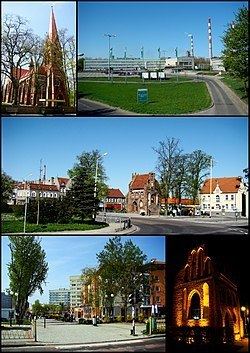Country Poland Gmina Gmina Police Postal code 72-009, 72-010, 72-011 Area 37.31 km² Local time Thursday 1:42 AM | County Police County Time zone CET (UTC+1) Car plates ZPL Population 41,745 (2014) | |
 | ||
Voivodeship West Pomeranian Voivodeship Weather 3°C, Wind W at 5 km/h, 79% Humidity | ||
Police [pɔˈlʲit͡sɛ] (German: Pölitz; Kashubian/Pomeranian: Pòlice) is a town in the West Pomeranian Voivodeship, northwestern Poland. It is the capital of Police County. As of 2007, the town had 34,220 inhabitants. This is one of the biggest towns of Szczecin agglomeration.
Contents
- Map of Police Poland
- History
- Post World War II
- Districts
- Geography and nature
- Population
- Infrastructure
- Culture and sport
- Hospital
- Notable residents
- Major corporations
- Twinning cities
- Towns near Police
- References
Map of Police, Poland
The town is situated on the Oder River and its estuary, south of the Szczecin Lagoon and the Bay of Pomerania. The centre of Police Town is situated about 15 kilometres (9 miles) north of the centre of Szczecin.
The name of the town comes from the Slavic pole, which means "field".
History
The settlement was first mentioned in 1243. Pomeranian duke Barnim of Pomerania granted Magdeburg law to the town in 1260. At the end of the 13th century, the town had become a fief of a local dynasty of knights, the Drake family. In 1321, with the death of Otto Drake, the town became a dependency of nearby Stettin (now Szczecin), hindering its growth until the mid-18th century.
Nearby Jasienica Abbey, now within the Police city limits, was secularized during the Protestant Reformation, which was adapted in the Duchy of Pomerania in 1534. After its secularization, the abbey became a ducal domain, and was the site of the treaty that for the first time partitioned the duchy into a western and eastern part (Pomerania-Wolgast and Pomerania-Stettin) in 1569.
From the Treaty of Stettin (1630) until the Treaty of Stockholm (1720), Pölitz was part of Swedish Pomerania, and of Prussian Pomerania thereafter. In 1808, Pölitz became independent from Stettin again. In 1815, Pölitz became part of the restructured Province of Pomerania, administered within Landkreis Randow county. In 1939, this county was dissolved and Pölitz was made part of Groß-Stettin.
In 1937, the synthetic fuel plant Hydrierwerke Pölitz AG was founded by IG Farben, Rhenania-Ossag, and Deutsch-Amerikanische Petroleum Gesellschaft which by 1943 was producing 15% of Nazi Germany's synthetic fuels, 577,000 tons. The plant derived its workforce from an adjacent system of camps (Pommernlager, Nordlager, Tobruklager, Wullenwever-Lager, Arbeitserziehungslager Hägerwelle, Dürrfeld Lager) plus a ship moored on the Oder River serving as a camp (Umschulungslager Bremerhaven). In addition, a subcamp of the Stutthof concentration camp was located in Pölitz. During World War II, the plant made Pölitz a bombing target of the Allied Oil Campaign leading to 70% of the town being destroyed.
Post-World War II
The city with the plant was captured by the Red Army during the Battle of Berlin on 26 April 1945. While most of the former German territory east of the Oder-Neisse line became Polish, Pölitz, situated on the western bank of the Oder, remained a Soviet-administered exclave: Marshal Zhukov decreed the establishment of a Soviet county with Pölitz, Ziegenort, Jasenitz, Messenthin and Scholwin. 25,000 German workers had to disassemble the plant before it was sent to the USSR. Gradually, the area without the plant was given to Poland: Mścięcino (formerly Messenthin) on 7 September 1946, and Police (formerly Pölitz) with Jasienica (formerly Jasenitz) on 19 September. On 25 February 1947 the plant also passed to Polish control. Polish settlers, partially expellees from the east of former Poland, arrived in the region to replace the German population that had fled or were forcibly expelled. They were joined by refugees from Greece and Yugoslav Macedonia in 1953.
The ruins of the plant still remain standing, though they are not secured and are dangerous to visit.
A large chemical plant (Zakłady Chemiczne "Police") was built in the town in 1969 and has grown since to become one of the largest in Poland. It produces mostly titanium dioxide pigments and nitrogen and phosphorus fertilizers.
Police was in the Szczecin Voivodeship from 1946 to 1998. Since 1999 the town has been part of the West Pomeranian Voivodeship.
Districts
Notable buildings from the pre-WW2 era:
The tourist and cultural information office is localised in The Gothic Chapel in Bolesław Chrobry Square in The Old Town of Police
Geography and nature
Police is situated on the Oder River and an estuary of the Oder River - Roztoka Odrzańska, south of the Lagoon of Szczecin and the Bay of Pomerania. The centre of Police Town is situated about 15 km (9 mi) north of the centre of Szczecin. Police is at located in the Ueckermünder Heide (Polish: Puszcza Wkrzańska) with the Świdwie Nature Reserve around Lake Świdwie (Polish: Jezioro Świdwie) near Tanowo and Dobra. A kayak route follows the Gunica River from Węgornik through Tanowo, Tatynia and Wieńkowo to Police-Jasienica. At the Szczecin Lagoon (Polish: Zalew Szczeciński, German: Stettiner Haff) is a small yacht marina on the mouth of the Łarpia River (part of Oder) - 'Olimpia'. The ruins of the synthetic petrol plant (Hydrierwerke Pölitz – Aktiengeselschaft) are now a habitat of bats (Barbastelle, Greater mouse-eared bat, Daubenton's Bat, Natterer's bat, Brown long-eared bat).
Population
Infrastructure
Major roads under state control connect Police to Trzebież and Nowe Warpno, No. 114; to Tanowo, No. 114; and to Szczecin over Przęsocin.
Main streets in Police include: ul. Tanowska, ul. Bankowa, ul. Grunwaldzka, ul. Kościuszki, ul. Jasienicka, ul. Dworcowa, ul. Piastów, ul. Wojska Polskiego, ul. Asfaltowa, ul. Cisowa, ul. Piłsudskiego, and ul. Wyszyńskiego.
Culture and sport
Hospital
A clinic hospital in Police (Siedlecka Street, The New Town, Osiedle Gryfitów) is a part of The Pomeranian Medical University.
Notable residents
Major corporations
Twinning cities
The sister cities of Police are:
